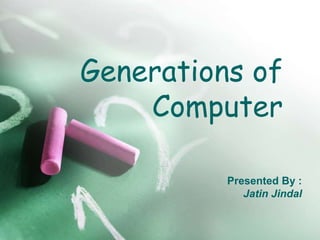
Generationsofcomputer
- 1. Generations of Computer Presented By : Jatin Jindal
- 2. Generations of Computer The history of computer development is often referred to in reference to the different generations of computing devices. Each of the five generations of computers is characterized by a major technological development that fundamentally changed the way computers operate, resulting in increasingly smaller, cheaper, more powerful and more efficient and reliable computing devices.
- 3. Asearly as the seventeenth century, mathematicians were trying to create a machine that could perform basic mathematical functions such as, addition, subtraction, division and multiplication.
- 4. 1804 British inventor, Charles Babbage, designed an all-purpose problem-solving machine, the difference engine, which had a mechanical memory to store the results of calculations.
- 5. Generations of Computer • First Generation • Second Generation • Third Generation • Fourth Generation • Fifth Generation
- 6. First Generation • The period of first generation was 1946-1959. • First generation of computers started with using vacuum tubes as the basic components for memory and circuitry for CPU (Central Processing Unit). These tubes like electric bulbs produced a lot of heat and were prone to frequent fusing of the installations, therefore, were very expensive and could be afforded only by very large organizations. • In this generation, mainly batch processing operating systems were used. In this generation, Punched cards, Paper tape, Magnetic tape Input & Output device were used. • There were machine codes and electric wired board languages used
- 7. The main features of First Generation are: • Vacuum tube technology • Unreliable • Supported Machine language only • Very costly • Generate lot of heat • Slow Input/output device • Huge size • Need of A.C. • Non-portable
- 8. Second Generation Transistors replaced vacuum tubes and ushered in the second generation of computers. The transistor was invented in 1947 but did not see widespread use in computers until the late 1950s. The transistor was far superior to the vacuum tube, allowing computers to become smaller, faster, cheaper, more energy-efficient and more reliable than their first-generation predecessors. Though the transistor still generated a great deal of heat that subjected the computer to damage, it was a vast improvement over the vacuum tube. Second-generation computers still relied on punched cards for input and printouts for output.
- 9. The main features of Second Generation are: • Use of transistors • Reliable as compared to First generation computers • Smaller size as compared to First generation computers • Generate less heat as compared to First generation computers • Consumed less electricity as compared to First generation computers • Faster than first generation computers • Still very costly • A.C. needed • Support machine and assembly languages
- 10. Third Generation • The period of third generation was 1965-1971. • The third generation of computer is marked by the use of Integrated Circuits (IC's) in place of transistors. A single IC has many transistors, resistors and capacitors along with the associated circuitry. The IC was invented by Jack Kilby. This development made computers smaller in size, reliable and efficient. • In this generation, Remote processing, Time-sharing, Real- time, Multi-programming Operating System were used. • High-level language (FORTRAN-II TO IV, COBOL, PASCAL PL/1, BASIC, ALGOL-68, etc.) were used during this generation.
- 11. The main features of Third Generation are: • IC used • More reliable and Faster • Smaller size • Generate less heat • Lesser maintenance • Still costly • A.C. needed • Consumed lesser electricity • Support high-level language
- 12. Fourth Generation • The period of Fourth Generation was 1971-1980. • The fourth generation of computers is marked by the use of Very Large Scale Integrated (VLSI) circuits. VLSI circuits having about 5000 transistors and other circuit elements and their associated circuits on a single chip made it possible to have microcomputers of fourth generation. Fourth Generation computers became more powerful, compact, reliable, and affordable. As a result, it gave rise to personal computer (PC) revolution. • In this generation, Time sharing, Real time, Networks, Distributed Operating System were used. • All the higher level languages like C and C++, DBASE, etc., were used in this generation.
- 13. The main features of Fourth Generation are: • VLSI technology used • Very cheap • Portable and reliable • Use of PC's • Very small size • Pipeline processing • No A.C. needed • Concept of internet was introduced • Great developments in the fields of networks • Computers became easily available
- 14. Fifth Generation • The period of Fifth Generation is 1980-till date. • In the fifth generation, the VLSI technology became ULSI (Ultra Large Scale Integration) technology, resulting in the production of microprocessor chips having ten million electronic components. • This generation is based on parallel processing hardware and AI (Artificial Intelligence) software. • AI is an emerging branch in computer science which interprets means and methods of making computers think like human beings.
- 15. • All the higher level languages like C and C++, Java, .NET, etc., are used in this generation. • AI includes: • Robotics • Neural networks • Game Playing • Development of expert systems to make decisions in real life situations. • Natural language understanding and generation.
- 16. The main features of Fifth Generation are: • ULSI technology • Development of true artificial intelligence • Development of Natural language processing • Advancement in Parallel Processing • Advancement in Superconductor technology • More user friendly interfaces with multimedia features • Availability of very powerful and compact computers at cheaper rates
- 17. THE END